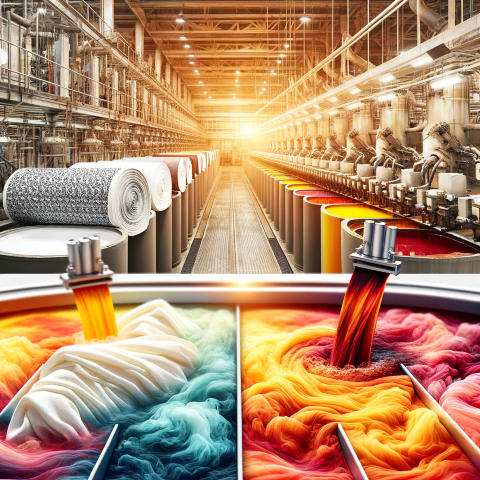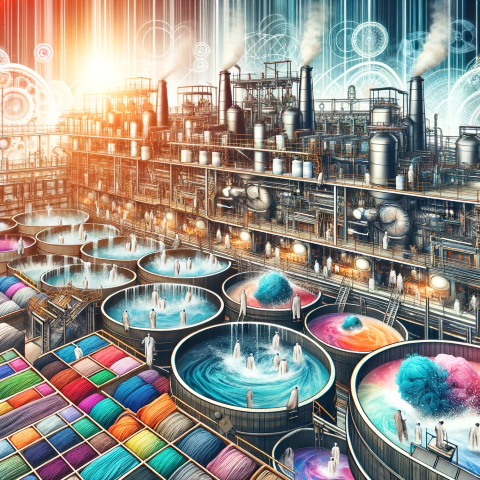Last Updated on: 14-Mar-2024 (4 months, 13 days ago)
Share on Facebook • Share on Twitter
Exploring the Art of Dyeing: Transforming Textiles with Color
The Comprehensive Guide to Dyeing in the Textile Industry
Dyeing in Textiles: Ancient Craft, Modern Innovations, and Future Trends
Dyeing, the transformative art of coloring textiles, has been an integral part of human civilization for millennia. Rooted in ancient practices, it has evolved through the ages, mirroring the cultural and technological advancements of societies. From the vibrant hues of natural dyes extracted from plants and minerals in ancient Egypt and India to the invention of synthetic dyes in the 19th century, dyeing has continuously reinvented itself. In today's global textile industry, dyeing stands at the intersection of art, science, and sustainability. It's not just about imparting beautiful colors; it's a complex process that balances aesthetic appeal with environmental responsibility. Innovations in dyeing techniques have led to more eco-friendly practices, crucial in an era increasingly focused on sustainability. As we delve into the world of textile dyeing, we uncover a fascinating blend of tradition, innovation, and ecological consciousness, revealing how this ancient craft continues to shape our material world, from fashion to furnishings, with vibrant colors and patterns. The practice of dyeing textiles dates back thousands of years, with evidence of dyed fabrics found in ancient civilizations such as Egypt, India, and China. Initially, dyes were derived from natural sources like plants, minerals, and insects. The industrial revolution brought synthetic dyes, which offered a wider range of colors and consistency. Today, dyeing is a critical aspect of the textile industry, continually evolving with technological advancements and shifting towards more sustainable practices.
Types of Dyeing Techniques in Textile Industry
- Natural Dyeing
This traditional method uses dyes derived from natural sources like plants, minerals, and insects. Ideal for organic and artisanal textiles, offering a range of earthy and muted tones. Eco-friendly and sustainable, it's gaining popularity in the wake of environmental consciousness. - Synthetic Dyeing
Utilizes man-made dyes created from chemical compounds. Widely used in mass-produced textiles due to its cost-effectiveness and wide color range. Offers vibrant, consistent colors and is suitable for various types of fabrics. - Reactive Dyeing
Involves chemical dyes that react and bond with fiber molecules. Commonly used for dyeing cotton and other cellulose fibers. Produces bright, wash-fast colors and allows for a variety of coloration techniques. - Vat Dyeing
A process where insoluble dyes are made soluble in a vat or container and then applied to the fabric. Suitable for dyeing cotton and other natural fibers. Produces extremely wash-fast and light-fast colors, ideal for workwear and denim. - Direct Dyeing
Involves applying water-soluble dyes directly to the fabric without any fixing agent. Often used for dyeing cotton, paper, leather, and rayon. A straightforward and economical process, though colors may be less vibrant compared to reactive dyeing.
Tips for Handling and Maintaining Dyed Fabrics
- Avoiding Direct Sunlight
Keep dyed fabrics away from prolonged exposure to direct sunlight. Sunlight can cause colors to fade, especially in naturally dyed textiles. This practice helps in preserving the vibrancy and color integrity of the fabric. - Using Mild Detergents
Wash dyed fabrics with mild detergents and avoid harsh chemicals. Harsh detergents can strip color and damage fabric fibers. Mild detergents help maintain color brightness and fabric softness. - Cold Water Washing
Use cold water for washing dyed textiles. Hot water can cause colors to bleed and fade. Cold water washing helps in preserving color fastness and reducing energy consumption. - Air Drying
Opt for air drying instead of machine drying. High heat from dryers can damage the color and texture of the fabric. Air drying is gentler on dyed textiles and environmentally friendly.
Major Manufacturers and Users of Dyeing Techniques
- Archroma
A global leader in color and specialty chemicals, known for its sustainable and innovative approach to textile dyeing. Offers a wide range of eco-friendly dyes and is renowned for its commitment to sustainability and innovation in dyeing technology. - Huntsman Corporation
An American multinational manufacturer and marketer of chemical products, including a significant focus on textile dyes. Known for its extensive range of high-quality dyes and commitment to developing new dyeing technologies. - DyStar
A leading dye manufacturer with a strong emphasis on sustainable and safe dyeing processes. Provides solutions across various types of dyes, catering to a broad spectrum of textile applications. - Atul Ltd
An Indian conglomerate with a substantial presence in the global textile dyeing industry. Offers a diverse range of dyes, known for its quality and innovative product range. - Clariant
A Swiss multinational company, prominent in the development of specialty chemicals, including advanced textile dyes. Focuses on creating eco-friendly dyes and advancing sustainable dyeing practices.
Applications of Textile Dyeing
- Fashion and Apparel
Dyeing is crucial in the fashion industry for creating visually appealing garments. It allows for a vast array of colors and patterns, essential in setting fashion trends and meeting consumer demands. Enables designers to experiment with different hues and styles, playing a vital role in the aesthetic appeal of clothing. - Home Textiles
Used in dyeing products like curtains, bed linens, and upholstery. Dyeing adds color and character to home decor, enhancing the overall aesthetic of living spaces. Critical for creating coordinated interior designs and customized home decor themes. - Technical Textiles
Involves dyeing materials for specialized applications, such as automotive, medical, and safety textiles. These require specific dyeing techniques to ensure color fastness and resistance to various conditions. Essential for meeting the stringent requirements of technical applications where functionality and durability are paramount. - Art and Craft
Dyeing plays a significant role in the arts and crafts sector, especially in custom fabric creations, tapestries, and artistic projects. Provides artists and craftsmen with the ability to infuse creativity and vibrant colors into their works. - Industrial Dyeing
Used for dyeing large volumes of fabric in industries. This includes uniform fabrics, automotive textiles, and other industrial-grade textiles. Enables mass production of consistently colored fabrics, crucial for uniformity in various industrial applications.
Envisioning a Colorful and Sustainable Future in Textile Dyeing
Dyeing in the textile industry embodies the convergence of ancient tradition and modern innovation. From the initial use of natural dyes to the creation of sophisticated synthetic colors, the progress of textile dyeing is a reflection of human creativity and technological advancement. Currently, as the industry confronts challenges like environmental sustainability and ethical production, dye manufacturers and users are shifting toward more environmentally friendly practices and materials. This amalgamation of tradition, innovation, and responsibility is expected to shape the future path of the textile dyeing industry, maintaining its significance and influence in an ever-evolving world.
The exploration of textile dyeing uncovers a vibrant and dynamic realm where color blends with creativity and tradition fuses with innovation. The evolution of dyeing, from the richness of natural dyes to the precision of synthetic colorants, reflects the ever-changing trends in fashion and functionality. As we gaze into the future, the emphasis on sustainability and eco-conscious practices in dyeing is becoming increasingly significant. Innovations in dyeing technology, motivated by environmental consciousness and ethical standards, are heralding a new chapter in the textile industry. Pioneers in this field, such as Archroma and Huntsman Corporation, are not merely coloring fabrics; they are crafting a vision of a sustainable and responsible textile industry. Their dedication to eco-friendly dyeing practices marks a shift in the industry's values, placing equal importance on the health of our planet and the aesthetic appeal of textiles. In summary, the art of dyeing, rich in history yet forward-looking, remains a fundamental aspect of the textile industry. It stands as a vibrant symbol of human ingenuity, merging beauty with responsibility, and ensuring that our fabrics are as sustainable as they are colorful.
The process of applying dyes to fibres, yarns, fabrics or garments. The type of dye, method used and liquor ratio (i.e. The amount of water used relative to the amount of fabric) has a huge influence on resource utilisation.
Some more terms:
Canvas Unleashed: Unraveling the Artistry and Allure of this Textile Wonder
Cotton, linen, or synthetic fabric made with an even weave in heavy and firm weights for sails and industrial purposes. Awning strips canvas has painted or woven stripes on cotton duck. Cross-stitch...
Read about CanvasProtease
Enzymes that are involved in the breakdown of proteins. They are the most widely used enzymes in detergents; it removes protein stains from egg, grass, blood, and sweat. Also used to treat wool and...
Read about ProteaseJacquard
Jacquard is a type of fabric characterized by intricate, woven patterns that are created using a special loom known as a Jacquard loom. The loom utilizes a system of punched cards to create intricate...
Read about JacquardForm Fitting
Form fitting is a term used in the textile industry to describe a garment or fabric that is designed to closely follow the contours of the wearer's body. It is characterized by a snug fit that...
Read about Form FittingGreige
Greige (pronounced "gray") is a term used in the textile industry to describe fabric that has not yet been finished or processed. Greige fabric is also referred to as "gray goods" or "loom-state...
Read about GreigeAllure of Selvedge Fabric: Exploring Beyond the Fray
The outer edge of both sides of a woven fabric where the weft turns to go back across and through the warp. This is a stiffer and denser woven area of about 1/3-1/2 inch and is usually trimmed off...
Read about Selvage or SelvedgeThe Journey of Denier: From Silken Coins to Textile Mastery
A system of measuring the weight of a continuous filament fiber. In the United States, this measurement is used to number all manufactured fibers (both filament and staple), and silk, but excludes...
Read about DenierPatina in Textiles: A Journey from Metal to Fabric
Title: Patina in Textiles: Unraveling its History, Types, and SignificanceIntroductionPatina, a term often associated with antiquity and aesthetics, holds an intriguing significance in the realm of...
Read about PatinaOn this page
Add a definition
- The term you want to define
- Its definition in 500 words or less
- Attach an image if necessary.
- Optionally, tell us about yourself in 200 words or less!
Companies for Dyeing:
- Company name
- Company address
- Attach a logo, if necessary.
- Optionally, tell us about yourself in 200 words or less!

 Fashion designer Abu Jani and Sandeep Khosla are known for their elaborate bridal couture.
Fashion designer Abu Jani and Sandeep Khosla are known for their elaborate bridal couture.

